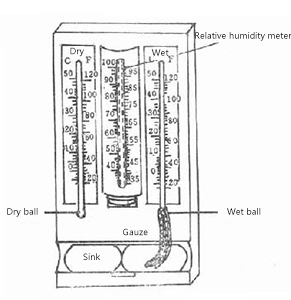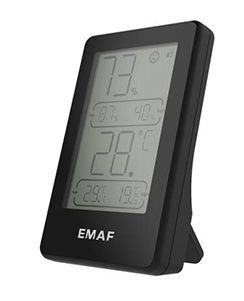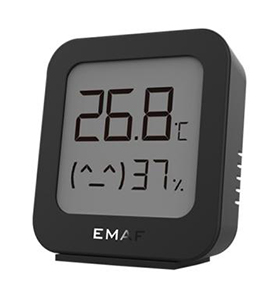Temperature and humidity sensors have been widely used in industry, agriculture, meteorology, medical treatment, and daily life. Different places and environments have specific requirements for temperature and humidity, correspondingly, people in different industries are required to obey specific temperature and humidity measurement standards. To achieve a reasonable temperature and humidity control, we are recommended to know some temperature and humidity measurement methods for the following two reasons.
Complicate humidity measurement methods
A temperature and humidity sensor is a device or device that converts temperature and humidity into electrical signals that can be easily measured and processed. Temperature and humidity sensors on the market generally measure temperature and relative humidity. Common humidity measurement methods are: dynamic method (double pressure method, double temperature method, split flow method), static method (saturated salt method, sulfuric acid method), dew point method, dry and wet bulb method and electronic sensor method.
1. The double pressure method and the double temperature method are based on the thermodynamics P, V, T balance principle, the balance time is longer, and the split method is based on the precise mixing of absolute moisture and absolute dry air. Due to the use of modern measurement and control methods, these equipment can be made quite precise, but because the equipment is complex, expensive, and time-consuming and labor-intensive, it is mainly used for standard measurement, and its measurement accuracy can reach ±2%RH-±1.5%RH.
2. The saturated salt method in the static method is the most common method in humidity measurement, which is simple and easy to implement. However, the saturated salt method has strict requirements for the balance of liquid and gas phases, and higher requirements for the stability of the ambient temperature. It requires a long time to balance, and the low humidity point requires longer. Especially when the difference between the indoor humidity and the humidity in the bottle is large, it needs to be balanced for 6-8 hours each time it is turned on.
3. The dew point method measures the temperature when the humid air reaches saturation, which is a direct result of thermodynamics, with high accuracy and wide measurement range. The accuracy of the precision dew point meter for measurement can reach ±0.2℃ or even higher. However, the cold mirror dew point meter using modern photo-electric principles is expensive and is often used in conjunction with a standard humidity generator.
4. The wet and dry bulb method, which is a method of measuring humidity invented in the 18th century. It has a long history and is most commonly used. The wet and dry bulb method is an indirect method. It uses the wet and dry bulb equation to convert the humidity value, and this equation is conditional: that is, the wind speed near the wet bulb must reach 2.5m/s or more. The common dry and wet bulb thermometer simplifies this condition, so its accuracy is only 5~7%RH, which is significantly lower than the electronic humidity sensor. Obviously, the wet and dry bulb does not belong to the static method. Don't simply think that as long as the measurement accuracy of two thermometers is improved, the measurement accuracy of the hygrometer is improved.

5. The principle of the electronic thermometer and hygrometer is to coat the surface of the electronic component or compound it into the component that is sensitive to humidity. When the humidity changes, the change in the physical properties of the humidity-sensitive material in the component affects the current or voltage that passes through the electronic component. It is converted into a temperature and humidity change value through the circuit and displayed on the electronic screen. This is the electronic temperature The working principle of the hygrometer.
Why use electronic temperature and humidity sensors?
Electronic humidity sensors have developed rapidly in recent decades. With small size, stable performance, and high accuracy, Electronic temperature and humidity sensors are widely used in various industries in production and life, mainly used for temperature and humidity measurement and centralized display control in communication rooms, offices, factories and mines, workshops, warehouses, archives, museums, HVAC, building automation and other environments.
In other words, the electronic humidity sensor can capture slight changes in air humidity, and convert the change of air humidity into electrical signal output, an electronic digital display is realized, which can be used to measure temperature and humidity and display the temperature and humidity changes.
In General, the characteristics of the electronic temperature and humidity sensor:
1. High precision;
2. Low drift;
3. Fast response speed;
4. Small size and easy installation;
5. Stable performance;
6. Long service life;
7. Strong anti-interference ability
With so many advantages above, we applied the measurement methods, which is the high-precision electronic temperature and humidity sensor to the design and production of our new product.
Application case:2020 New Design Indoor Digital Hygrometer Thermometer

2020 New Design Indoor Digital Hygrometer Thermometer

2020 New Design Mini Indoor Digital Thermometer Hygrometer With Magnet
These two thermometers and hygrometers use high-precision electronic temperature and humidity sensors, which not only accurately measure humidity, but also have excellent temperature accuracy. The temperature measurement range is -40°C-90°C (-40°F~194.0°F) The humidity measurement range is 10%-99%. In most measurement intervals, the temperature measurement accuracy is ±1℃, and the humidity measurement accuracy is ±3%, which meets the accuracy requirements of most use scenarios.
These two products not only have high measurement accuracy but also added the emoji somatosensory expression system for the first time, making the complicated temperature and humidity relationship more intuitive. From top to bottom are the environmental humidity, environmental temperature, large fonts, and clear visual effects. If you want to know whether the indoor temperature and humidity have reached the optimal state, you can immediately perceive it through intuitive smiling and crying faces. Even more attractive is its pocket design, which can be take with wherever we are.
Potential application scenarios
Whether at home or out, an accurate understanding of temperature and humidity can help improve our comfort. According to the research of physiologists, the temperature and humidity of the human environment will also directly affect the human body temperature regulation function and heat conduction effect. As a result, the adaptability of people's somatosensory is reflected in the agility of thinking activities and the excellent mental state, which affects the efficiency of our study and work. After testing and analysis, the most suitable room temperature for the human body should be 18℃, and the humidity should be 40% to 60%.
In the future, the temperature and humidity sensor market has broad prospects, especially in the fields of consumer electronics and the Internet of Things. For example, it plays an important role in scenes such as baby care, fresh fruits, and healthy meals. Therefore, IC semiconductor temperature and humidity sensor products with small size, low power consumption, low cost and high integration will be more popularized and applied.
 online service
online service 0086-591-8806 9579
0086-591-8806 9579 88067049
88067049 izzy@lexinda.com
izzy@lexinda.com sarahlpr
sarahlpr 86-15336506363
86-15336506363